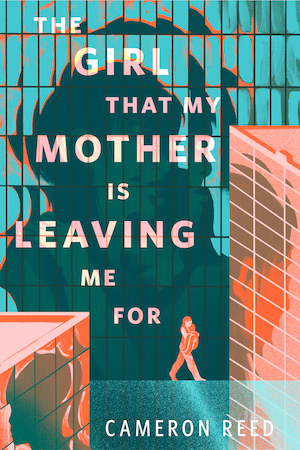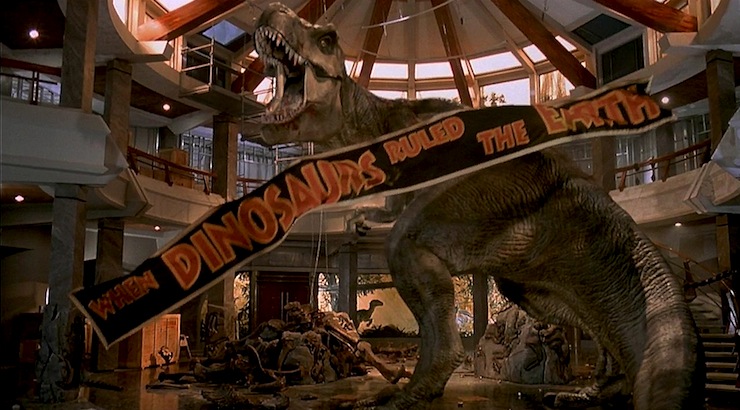There’s a meme going around of late. There may be variations, but the one I’ve most frequently seen features a tableau by Russian paleoartist Vasily Vatagin portraying a few of the more well-known dinosaurs—brontosaurus, stegosaurus, etc.—in the wild. It’s accompanied by the following text, which I’ll transcribe with the dodgy punctuation intact, just to give you the full flavor of the thing: “The dinosaurs didn’t ‘rule the Earth’, they were just alive. Stop giving them credit for administrative skills they almost certainly did not have.”
It bugs me, that meme. I get the semantics game that’s being played, and if you’ve been reading my pieces, you know I’m no stranger to that kind of snark myself. But in this case, there’s something so dour, so unromantic about the thing that it gets my hackles up. Whenever that meme manifests in my Facebook feed, I always post the same comment: “Ask any eight-year-old whether dinosaurs rule. You’ll have your answer.”
And that got me thinking: Why am I taking such offense to this little bit of linguistic tomfoolery? And why was my automatic reaction—which actually did come as soon as I’d first laid eyes on that meme—to bring up how obsessed kids are with dinosaurs?
Truth in journalism: As a child I was never that into dinos. They may not have been as prevalent in the culture as they are now, but they were around, lots: museums; books; movies; View-Master reels. The 1964/1965 New York World’s Fair (yes, we’re back to that), was sloppy with ‘em, their presence being the most radical invocation of the Fair’s prevailing theme of the ever-onward March of Progress. I took note of them, but wasn’t in awe of them; they didn’t stir my imagination as they did some of my friends.
The awe is there now. And the more I think about it, the more I believe that what instilled it was Jurassic Park (1993). What’s surprising about that is that my original reaction to Steven Spielberg’s mega-ultra-super-blockbuster was… not exactly negative (an amazing film is an amazing film, after all) but did contain reservations. On the one hand, there was the behind-the-scenes drama that saw stop-motion animator Phil Tippett being shunted aside from his dream project in favor of Industrial Light and Magic’s computer generated dinos (a tale more fully told in the 2022 documentary Jurassic Punk). On the other, there was Spielberg’s push-pull navigation of a narrative that saw the emotional beats rapidly swinging from wide-eyed wonder to abject terror. For me, Jurassic Park at last cemented my growing sense that to watch a Spielberg action film was to be running with the director’s Mammoth Entertainment Machine, and if you didn’t keep up, it was going to CRUSH you.
Part of my reservations centered on the loci of those wild mood swings: Lex and Tim Murphy (Ariana Richards and Joseph Mazzello), the grandchildren of Jurassic Park’s mastermind, John Hammond (Richard Attenborough) and conduits through which paleontologist Alan Grant (Sam Neill) becomes accustomed to the notion that he can handle the responsibilities of being a father. As tools for generating audience empathy, they’re perfect. But the way Spielberg uses them would make anyone wonder how those kids weren’t traumatized into a catatonic state by the end of the film. At one second they’re in a jeep toying with touchscreens and night-vision goggles, the next they’re being nearly crushed to death by a Tyrannosaurus rex. They escape a plummeting vehicle, and wake up the next morning to have a meet-cute with a dino whose head is as big as their bodies (with Lex getting a baptism in snot for her troubles—not groovy, Steven). Tim later goes all “Oh, cool” while watching the T-rex slaughter some prey, and not much later becomes terrified prey himself. He also gets electrocuted. That Tim is made of some stern stuff, yessir.
Buy the Book


Mislaid in Parts Half-Known
It’s a lot. It really is a lot, as is Spielberg’s wont. But I’ll say this: If Spielberg is merciless in the way he whipsaws emotional states, he does it with meticulous proficiency. After Jaws and Close Encounters and Raiders and E.T., etc., etc., he knows just the right buttons to push, and exactly when to push them. If I’m left feeling ruthlessly pummeled by the experience, I can’t help but respect the artistry.
Just as I have to concede that while, as I’ve stated elsewhere, I prefer the magic of physical models and stop-motion animation, the revolutionary use of CG—which is not as prevalent in the film as legend has it—was absolutely the right call. In that first scenic tableau, when Spielberg captures a field of dinos running free, we feel like we are truly witnessing the towering beasts returned to our world. It’s that moment—framed by John Williams’ beautiful Jurassic Park theme, with Sam Neill and co-star Laura Dern mirroring the audience’s amazement—that sprung to mind when I first laid eyes on that frelling meme. Don’t tell me dinos don’t rule, buddy. Steven Spielberg showed me better.
And the more I think about it, the more I get why, as much as the adults are supposed to be Jurassic Park’s main protagonists, it’s the kids who drive the Jekyll/Hyde narrative structure, and in a round-about way explain a child’s fascination with dinosaurs. Dinos are, first and foremost, fantastic creatures, immense and powerful, that were nevertheless real. Yet they exist within a realm of speculation—science has filled in a lot of the gaps, but many more remain, room enough for a child’s imagination to take over, space for small beings, aware of their own vulnerability, to dream of such near-limitless power. And if those real-life monsters were mostly harmless—giant cows, as Grant counsels his temporary wards—those that weren’t have been rendered harmless by some sixty-five million years of time. A child, still learning the ins-and-outs of the real world, can contemplate the violence, knowing it can’t touch them. Even before it hits the screen, the world of dinos is the action movie of a young person’s mind.
All of that applies to adults as well, but with a further aspect, one maybe only instinctually considered by children but better appreciated by adults: The concept of extinction. Dinosaurs once were dominant, but now they’re not. The age of dinosaurs lasted for—according to the U.S. Geological Survey—some 165 million years. Per the USGS, that earns them respect as “…unqualified successes in the history of life on Earth.” And all that came to an end. There are lots of conjectures about what killed the dinosaurs—asteroids, volcanos, earthquakes (my favorite is a since-debunked theory that diarrhea was the culprit, but that’s my internal eight-year-old talking). Whatever the reason, they were wiped out by forces beyond their control, and unmindful of their dominion. And here we sit, the (relatively) new alphas, looking at what came before, and then cautiously glancing over our shoulder for the asteroid that has our species designation on it. (It should also be noted that Spielberg’s DreamWorks production company was responsible for the more sober of the two killer asteroid movies of 1998, Deep Impact.)
It’s interesting, though, how many tales of dinosaurs go out of their way to envision the extinction event. Walt Disney’s Rite of Spring sequence from Fantasia (1940) goes whole-hog, tracking the genesis of life from microbes all the way to the dinos dying out from drought and starvation, with an earthquake thrown in for good measure (and because it fit the music). It’s an impressive bit of animation, downright impressionistic in its portrayal of an aborning earth roiled by volcanos and flooded by waters; and both majestic and monstrous in its vision of the age of dinos. Did Spielberg learn a bit from the old Mousetro about using mise en scene to guide an audience’s emotions? Do meteorological conditions in Disney’s prehistory shift abruptly from placid to raging thunderstorm when there’s a smash-cut to a ravenous T-rex? (You bet it does.)
(Fun fact: When I was a freshman in high school, the science teacher one day came in and announced, “I’m going to show you a cartoon about dinosaurs. It’s not scientifically accurate, but we’re going to watch it anyway.” Soon as the Stravinsky soundtrack kicked in, I exclaimed, “Hey, it’s Fantasia! That’s Fantasia! Forget about science, this is GREAT!” I imagine how thrilled the teacher was to have to surrender time from his cigarette break in order to shut up the nerdy kid in the back.)
Sixty years later, Disney’s CG-animated Dinosaur (2000) envisioned a quasi-extinction event through a meteor impact, and before that film lent its name to an attraction at the company’s Animal Kingdom park, the ride was called Countdown to Extinction. Even the time-travel sequence in The Simpsons’ “Treehouse of Horror V” (1994) shows Homer single-handedly wiping the dinosaurs out with one, misplaced sneeze, while Jim Henson Productions’ Dinosaurs (1991-1995)—whose whole premise was to parallel the dinos’ doom with all the stupid stuff we’re currently doing to ourselves—offered a series finale that pointedly had extinction coming through self-inflicted climate catastrophe.
More relevantly, Jurassic World: Fallen Kingdom (2018), the second installment of the considerably inferior follow-up franchise—which regrettably was directed by A Monster Calls’ J.A. Bayona (monthly SF criticism is a flat circle)—has its own mini-extinction halfway through the film, with the dinos of Isla Nublar perishing in a volcanic eruption while the narrative rather rudely moves on to other, less interesting matters. For his part, Spielberg decided not to go for full-on apocalypse at the end of Jurassic Park, choosing intimations more subtle and multi-layered. The paleontologists, laying eyes on Hammond’s cloned dinos, are forced to contemplate the extinction of their own profession—who needs bones when you can get the beasts in the flesh? (The original novel by Michael Crichton—who co-wrote the screenplay with David Koepp—goes into a bit more depth on this.) Better still is the climactic shot —my favorite of the movie—where the Tyrannosaurus rex, having vanquished the velociraptors, stands within the trashed atrium of the park’s welcome center, roaring her triumph as a tattered banner with the legend… wait for it… “When Dinosaurs Ruled the Earth” falls to her feet.
On top of the marvelous, Spielbergian trick of turning a Big Bad into the film’s ultimate hero (albeit one the characters still wisely flee at first opportunity), that shot says so many things: A slap at us humans for paying lip-service to forces of nature we don’t fully comprehend and can’t possibly control; an acknowledgement of the limits with which we can impose order within a chaotic universe (helloooooo, Dr. Malcolm!); and most affectingly, a reminder that dominance—even if it lasts some 200 million years—does not endure forever.
The dinosaurs rose, and fell, and we may as well. Our advantage is the capacity to better comprehend our world, anticipate the threats, and take action against the ones we’re capable of vanquishing. Whether that will guarantee we extend our longevity past the age of dinosaurs remains to be seen—our friends at the USGS note that if a calendar framed life from the advent of the dinosaurs to the present, dinos would be around through sometime in September, while we humans are stuck all the way at New Year’s Eve. That’s a daunting challenge, but we have the benefits of evolution on our side—at the very least, we’re not cursed with T-rex’s teeny-tiny arms. Sixty-five million years after dinosaurs ruled the Earth, we can at least put up a good, non-CG animated fight.
* * *
I’ll admit that at times I feel that Steven Spielberg is too skilled in his ability to manipulate an audience’s feelings, and occasionally too profligate in how he deploys that tool. But there are worse crimes with which to accuse a filmmaker, and I don’t have any hesitation in counting Spielberg among the greatest of directors, and Jurassic Park as standing among the best of his works. But what do you think? Is Jurassic Park an exploration of humanity’s doomed trajectory, vis-à-vis the dinosaurs, or is it just two hours of rave-up fun? The comments section is below, feel free to contribute. (I know all you Hunky Ian Malcolm fans are just champing at the bit.) Be kind, have fun, and let’s all meet in the cafeteria afterward for ice cream.
Dan Persons has been knocking about the genre media beat for, oh, a good handful of years, now. He’s presently house critic for the radio show Hour of the Wolf on WBAI 99.5FM in New York, and previously was editor of Cinefantastique and Animefantastique, as well as producer of news updates for The Monster Channel. He is also founder of Anime Philadelphia, a program to encourage theatrical screenings of Japanese animation. And you should taste his One Alarm Chili! Wow!











I will say this for Fallen Kingdom. It’s not a good movie (I think it’s the worst of the franchise), but it at least tries to be different. The previous four were basically the same film over and over.